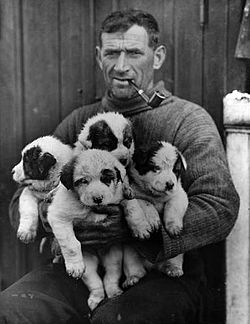
Eating Your Transport

In the tradition of nineteenth-century European journeys to remote areas of Africa, Asia, and the Arctic, some heroic-age expeditions brought beasts of burden to Antarctica that in hard times became meat for the hoosh. Ponies and dogs hauled and then became fodder. After his desperate experience on the ice, Douglas Mawson reasoned that "in an enterprise where human life is always at stake, it is only fair to put forward the consideration that the dogs represent a reserve of food in cases of extreme emergency." Few things are as efficient on a life-or-death journey as the ability to eat your transportation.Mostly this was a British affair. Of eighteen heroic-age expeditions, fifteen brought beasts of burden, but only six (four British, one Australian, and one Norwegian) converted them into food. Scott's Discovery expedition fed dogs to dogs as provisions dwindled. On Shackleton's Nimrod expedition, Siberian ponies pulled sledges full of supplies for his depots on the Ross Ice Shelf before their worn-out carcasses became supplies in the depots. Shackleton was careful to eat this fresh, heavy meat before the lightweight, concentrated pemmican they could carry farther. Sometimes they chewed raw cubes of it as they walked. "One point which struck us all," Shackleton wrote later, "was how man's attitude towards food alters as he goes South. At the beginning, a man might have been something of an epicure, but we found that before he got very far even raw horse-meat tasted very good." Best of all, he said, was blood from a butchered pony frozen into an icy mass in the snow, which was then boiled to thicken the hoosh. Socks, Shackleton's last pony, fell into a crevasse just hours before he was due to be shot and cut up for food. Shackleton later posited that "the loss of Socks, which represented so many pounds of meat," might have cost them the Pole.
In Shackleton's shadow, Scott returned in the Terra Nova to follow the same path to the Pole, using the same ill-suited ponies as transport. As the first five were shot along the trail, each made four or five meals for the dog teams. Scott reported that his men enjoyed the change too: "Tonight we had a sort of stew fry of pemmican and horseflesh and voted it the best hoosh we had ever had on a sledge journey."
Sometimes it was extreme necessity that drove the men to eat the burdened beasts. Douglas Mawson and Xavier Mertz resorted to eating their dogs only when all other options had disappeared into a black crevasse. Shackleton's Endurance tale makes it plain that once the disintegration of Weddell Sea ice forced them into crowded boats, there would be no place for their beloved dogs. Shackleton ordered them shot and eaten. It tasted "just like beef," he said, "but, of course, very tough."
The name most associated with eating domesticated animals in Antarctica is Roald Amundsen, whose slaughter of twenty-four healthy dogs is infamous. Amundsen's Butcher's Shop, like Scott's Shambles Camp, marked not just the end of these animals' lives but also the place where carcasses were dressed for consumption. "Great masses of beautiful fresh, red meat, with quantities of the most tempting fat, lay spread over the snow" wrote Amundsen, a hungry Norwegian epicure for whom the dogs' corpses recalled "memories of dishes on which the cutlets were elegantly arranged side by side, with paper frills on the bones, and a neat pile of petit pois in the middle."
The story here is neither of epicurean savagery nor even of human hunger, but of transport management. Amundsen, the most professional and shrewd of polar explorers, created a calculus of weights carried and weights consumed for every day of the roundtrip journey to the Pole. He related this to the pulling power of a dog --- how many pounds on the sledge each dog could haul. As food and fuel were consumed, weight on the sledge diminished, and at a certain point that lost weight would equal a dog's pulling power and the dog became superfluous. Amundsen then related "the average weight of edible flesh of a dog and its food value when eaten by the others. By these calculations," he wrote, "I was able to lay out a schedule of dates upon which dog after dog would be converted from motive power into food." In this analysis, some dogs were killed so others lived comfortably on the trail. After twenty-four dogs were killed at the Butcher's Shop and after the Norwegians had been to the Pole, six more were slaughtered, one at a time, so the surviving dogs actually gained weight on the return journey. The open question is how many more dogs might Amundsen have brought home safely had he not stuck to his calculation so firmly.
Though Amundsen shows real affection for individual dogs throughout the story, he was a man on a mission. The animals were slaves to his cause, and so completely did Amundsen believe in that cause that he could write casually of their destruction: "I must admit that [the cutlets] would have lost nothing by being a little more tender, but one must not expect too much of a dog." In fact, Amundsen expected everything of them, and he got it.
--- From Hoosh
Jason C. Anthony
©2012 University of Nebraska Press